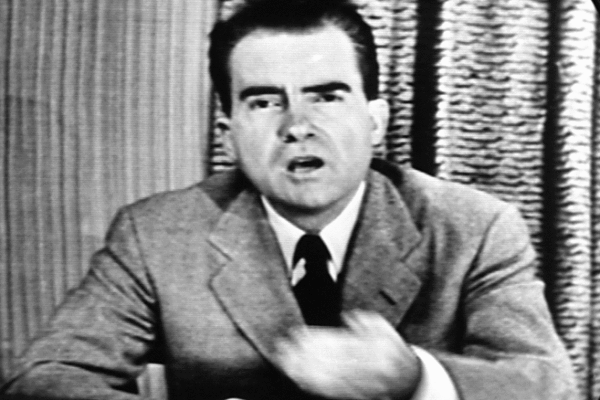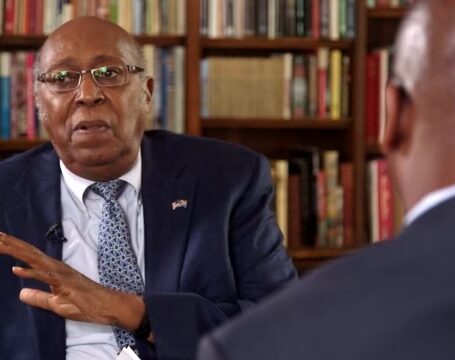 Public Policy
Public Policy Vice Presidents: American Politics’ Vestigial Organ

In one of the few instances where anything a vice president did made news, Richard Nixon defended himself against charges of financial improprieties in the famous Checkers speech when he was the running mate of Dwight Eisenhower in 1952.
“Once there were two brothers: one ran away to sea, the other was elected Vice-President — and nothing was ever heard from either of them again.”
Thomas R. Marshall, vice president under Woodrow Wilson
“The vice presidency is not worth a bucket of warm spit.”
John Nance Garner, Franklin Delano Roosevelt’s first vice president
In the next few weeks the presumptive nominees for U.S. president, Donald Trump and Hillary Clinton, will make what is often called the “first major decisions of their prospective presidencies,” the choice of a vice president to run with them and serve in their administrations.
As demonstrated by the quotes above, some of those chosen have not viewed their selection as an honor. Concerned about the newly unelected Vice President Gerald Ford, Arthur Schlesinger Jr. in a May 1974 article in The Atlantic asked, “Is the Vice Presidency Necessary?”

Howard J. Silver served for a quarter century as the executive director of the Consortium of Social Sciences Agencies. His blog appears monthly at Social Science Space.
Article II of the Constitution discusses the vice president in relation to the method of electing the president through the Electoral College. The original idea was that the states would choose their electors, who would then vote for two candidates. The one with the most votes became president and the second-place finisher became vice president. One other stipulation was that electors could not cast two ballots for someone from their own state. The document also discusses the elevation of the vice president to the presidency in case of the death or removal of the president. In addition, Article I declares that: “The Vice President of the United States shall be President of the Senate, but shall have no vote, unless they be equally divided.”
Alexander Hamilton, writing in Federalist #68 (long before he became a Broadway phenomenon), in defending the indirect election of the president, also discussed the vice presidency. He wrote, “The appointment of an extraordinary person, as vice-president, has been objected to as superfluous, if not mischievous.” He adds that some wanted the Senate to elect the vice president, but rejects this by citing the position of lieutenant governor that already existed in New York and other states. Elbridge Gerry of Massachusetts, the only delegate to the Constitutional Convention to serve as vice president, opposed the creation of the office.
In the beginning of the nation, this provision gave us John Adams and Thomas Jefferson as vice presidents. However, with the rise of political parties in the election of 1800, two persons from the same party tied for the presidency, Jefferson and Aaron Burr. Under the Constitution the election was decided by the House of Representatives. This led to the adoption of the 12th Amendment in 1804 requiring the Electoral College to vote for president and vice president separately, with the expectation that the two would come from the same party.
Thus began the movement of vice presidents into their obscurity, leading commentators to suggest the main purpose of the number two was to sit around waiting for the president to die. This has happened eight times in American history. In addition, in 1974 President Richard Nixon resigned, elevating Gerald Ford, who had been elected vice president by the Congress under the provisions of the 25th Amendment. This enactment of this amendment arose to deal with vice-presidential vacancies and presidential disability, the latest example of the first situation followed President Kennedy’s assassination, and the second occurred during President Eisenhower’s heart attack and other ailments.
Since Adams and Jefferson, only two vice presidents have been elected to the presidency immediately following their service, Martin Van Buren in 1836 and George H.W. Bush in 1988. Richard Nixon tried in 1960, but didn’t succeed until 1968, when he defeated another V.P. trying to move up, Hubert Humphrey. Of the eight who came to office on the death of the president, the four who succeeded to the presidency in the 19th century — John Tyler, Millard Fillmore, Andrew Johnson, and Chester Arthur — could not even secure their party’s nomination to remain in office. Only the four in the 20th century also secured election in their own right: Theodore Roosevelt, Calvin Coolidge, Harry Truman, and Lyndon Johnson.
Those four had significant political careers before their bosses tapped them for the vice presidency, but each had not played significant roles in the administrations they served. TR had been governor of New York and a reforming New York City police commissioner, but became McKinley’s vice president in 1900 because Tom Platt, the Republican boss of New York, wanted him out of the state. Coolidge, as governor of Massachusetts, gained renown for ending the Boston Police Strike in 1919, and became Warren G. Harding’s running mate after a delegate revolt at the 1920 Republican convention. Although he became the first V.P. invited to sit in on Cabinet meetings, Coolidge’s tenure as number two was not very eventful.
Truman became Franklin Roosevelt’s third vice president after becoming a national figure chairing a Senate subcommittee that investigated war time profiteering in the early 1940s. However, we now know that FDR kept Truman in the dark regarding the Manhattan Project to build the atomic bomb. LBJ, the Senate majority leader, was chosen as John F. Kennedy’s running mate — over the vehement objections of Robert Kennedy — to help the presidential nominee hold the South, especially Texas. Johnson’s found his tenure as vice president deeply frustrating. He tried to use the V.P.’s position as president of the Senate to maintain his role as leader of the Democrats in the Senate. His former colleagues stymied that idea. Kennedy appointed him to chair various commissions and councils and sent him on diplomatic missions, but it was clear that his peripheral role in the Kennedy administration discouraged Johnson immensely.
Eisenhower’s number two, Richard Nixon, was selected at age 38 to contrast with the elderly Ike and mollify the anti-communist crowd in the Republican Party. Nixon became the political face of the administration, as Ike portrayed himself as above the fray. The V.P. also gained attention for his kitchen debate with then-Soviet leader Nikita Khrushchev and for almost losing his life during anti-U.S. demonstrations in Caracas, Venezuela, both in 1959. Once he himself became president, Nixon used his own vice president, Spiro Agnew, for political purposes, and little else. Agnew would subsequently resign the office for taking bribes.
Some vice presidents in the late 20th century and early 21st have had important roles in their administrations. This probably began with the relationship of Jimmy Carter and Walter Mondale. Mondale was the first vice president to have an office in the White House and established the tradition of weekly lunches with the president. He became more of a presidential adviser, rather than a frustrated figurehead.
George H.W. Bush had been Ronald Reagan’s chief competitor for the GOP nomination in 1980. After failing with his grandiose scheme to make former President Ford his number two, Reagan turned to Bush, who had been a congressman, a loyal chairman of the Republican Party during the Watergate debacle, and CIA director. Aside from the regular weekly luncheons with the president that by now had become an institution, Bush became the first vice president to serve as acting president under the terms of the 25th Amendment, when President Reagan underwent an operation in July 1985. Bush served for eight hours.
When it came time to pick his own number two, Bush plucked a somewhat obscure young senator from Indiana, Dan Quayle. Quayle had done some interesting work on education in the Senate, but people remember his vice presidency for the fumbles at his introductory press conference as the designated nominee, his flubs as a speaker and speller (the famous “potatoe” incident that got endlessly ridiculed), and his controversial attack on a television character, Murphy Brown, for having a baby out of wedlock. Some wanted to dump Quayle from the ticket in 1992, as some had urged Ike to do with Richard Nixon in 1952 and 1956, but Bush kept him on.
Bill Clinton’s selection of Tennessee Senator Al Gore in 1992 surprised many. The conventional wisdom was that presidential candidates choose contrasting figures to run with. Clinton, however, wanted a new generation, those born post-World War II, to lead the “new” Democratic party. Gore’s early tenure was marked by casting the tie-breaking vote in the Senate that allowed the Clinton tax increase to pass in 1993. He also focused on an administration initiative to “Reinvent Government,” by reducing waste, fraud, and abuse, and streamlining the bureaucracy. He had a major focus on technology, particularly the Internet, and the environment The Monica Lewinsky affair and the subsequent impeachment battle alienated Gore from Clinton, perhaps some have suggested to his detriment in the 2000 presidential race.
Dick Cheney, who chaired George W. Bush’s vice presidential selection committee, decided there was no one better than himself. The former congressman, secretary of defense, and White House chief of staff under Gerald Ford became, especially in Bush’s first term, perhaps the most influential number two in history. The perception was that he and his band of neo-conservatives were running American foreign policy, responding to the war on terror, sanctioning torture, and precipitating the disaster in Iraq. Barton Gellman in his biography of Cheney, Angler, also asserts that he had critical influence on budgetary and domestic policy, particularly on energy and the environment. However, after Bush’s re-election and the change in Iraq policy with the surge, countervailing forces in the administration, notably Condoleezza Rice and Robert Gates, began to ascend and Cheney’s role diminished.
Barack Obama chose veteran Delaware Senator Joe Biden as his running mate in 2008. Biden had run for the presidency in 1988 and 2008 without any success. However, his long Senate career, he was first elected in 1972, led to his chairmanship of the Senate Foreign Relations Committee. He had also led the Judiciary Committee that put him in the forefront of criminal justice policy, including the enactment of the Violence Against Women Act. He also had a compelling personal story and had come from blue collar, working class origins. After the death of his son Beau from cancer, Obama put Biden in charge of what’s being called “The Cancer Moonshot.” During the past eight years it is clear Biden has had a significant role in administration policy. He has helped negotiate for Obama on the Hill and participated in the many foreign policy debates that have shaped the administration’s responses to world events. He has however, not always prevailed with his views.
As Trump and Clinton get set to choose their running mates, the selection criteria have been turned upside down over the years. We have had the first woman candidate, Geraldine Ferraro in 1984, and the first Jewish candidate, Joe Lieberman in 2000, both on losing Democratic tickets. Political geography doesn’t appear too important anymore as some recent candidates such as Paul Ryan in 2008 and John Edwards in 2004, have been unable to deliver their states for their ticket. Political scientists have generally agreed that voters do not make their choice for president based on the running mate (Sarah Palin may have been an exception in 2008), so the nominees have pretty much free rein. The most important thing might be to do a thorough background check so that the disaster that befell George McGovern with Thomas Eagleton in 1972 does not recur. Next important is to have the candidates define their relationship post-victory so that the vice president does not get lost at sea again.































































































